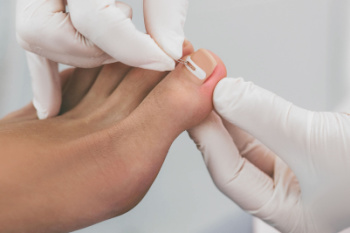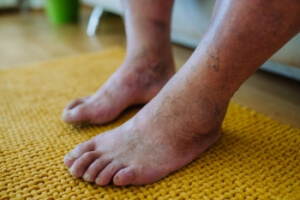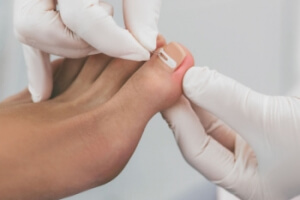
Why Diabetic Patients Experience Foot Problems
 Diabetic patients often experience foot problems due to poor blood circulation and nerve damage, or neuropathy, caused by prolonged high blood sugar levels. Reduced blood flow can lead to slow healing of cuts and sores, while neuropathy can cause numbness, tingling, or a loss of sensation in the feet. This combination increases the risk of developing ulcers and infections, and injuries may go unnoticed. Diabetic foot symptoms include swelling, redness, warmth, and pain. Some individuals may feel a burning or sharp pain, while others might experience complete numbness. Foot deformities like hammertoes or Charcot foot can also develop causing discomfort and instability. To manage these issues, diabetic patients should maintain proper blood sugar levels, perform daily foot inspections, wear appropriate footwear, and practice good foot hygiene. Regular check-ups with a podiatrist are essential. If you have diabetes, it is strongly suggested that you seek comprehensive care from this type of doctor, who can perform regular foot evaluations and offer preventive measures tailored to diabetic needs.
Diabetic patients often experience foot problems due to poor blood circulation and nerve damage, or neuropathy, caused by prolonged high blood sugar levels. Reduced blood flow can lead to slow healing of cuts and sores, while neuropathy can cause numbness, tingling, or a loss of sensation in the feet. This combination increases the risk of developing ulcers and infections, and injuries may go unnoticed. Diabetic foot symptoms include swelling, redness, warmth, and pain. Some individuals may feel a burning or sharp pain, while others might experience complete numbness. Foot deformities like hammertoes or Charcot foot can also develop causing discomfort and instability. To manage these issues, diabetic patients should maintain proper blood sugar levels, perform daily foot inspections, wear appropriate footwear, and practice good foot hygiene. Regular check-ups with a podiatrist are essential. If you have diabetes, it is strongly suggested that you seek comprehensive care from this type of doctor, who can perform regular foot evaluations and offer preventive measures tailored to diabetic needs.
Diabetic foot care is important in preventing foot ailments such as ulcers. If you are suffering from diabetes or have any other concerns about your feet, contact Monique Mitchell, DPM from Family Foot Centre. Our doctor can provide the care you need to keep you pain-free and on your feet.
Diabetic Foot Care
Diabetes affects millions of people every year. The condition can damage blood vessels in many parts of the body, especially the feet. Because of this, taking care of your feet is essential if you have diabetes, and having a podiatrist help monitor your foot health is highly recommended.
The Importance of Caring for Your Feet
- Routinely inspect your feet for bruises or sores.
- Wear socks that fit your feet comfortably.
- Wear comfortable shoes that provide adequate support.
Patients with diabetes should have their doctor monitor their blood levels, as blood sugar levels play such a huge role in diabetic care. Monitoring these levels on a regular basis is highly advised.
It is always best to inform your healthcare professional of any concerns you may have regarding your feet, especially for diabetic patients. Early treatment and routine foot examinations are keys to maintaining proper health, especially because severe complications can arise if proper treatment is not applied.
If you have any questions please feel free to contact our office located in Garden Hills, Nassau, Bahamas . We offer the newest diagnostic and treatment technologies for all your foot and ankle needs.
Diabetic Foot Conditions
Diabetes is the condition in which the body does not properly process food for use as energy. People with Type 1 diabetes cannot produce insulin, which is required for glucose to feed your body’s cells. It is typically caused by the immune system mistaking healthy cells for foreign invaders and destroying the insulin-producing cells in the pancreas. On the other hand, people with Type 2 diabetes cannot respond to insulin properly, and eventually cannot produce enough. The Centers for Disease Control and Prevention reports that over 30 million people in the United States have diabetes, with 1 in 4 having no idea they have it. Surprisingly, diabetes is the seventh leading cause of death in the US. The symptoms of diabetes include frequent urination, fatigue, hunger, and even blurry vision.
Diabetes can also affect the feet as well. Over time, diabetes can cause nerve damage to your feet, which could then lead to symptoms such as tingling, pain and numbness in the feet. Neuropathy can be very dangerous to a person with diabetes, since it prevents them from feeling injuries such as cuts or blisters in the feet, and if not detected early enough, may lead to infection. Neuropathy can also lead changes in the shape of your feet and toes. The best way for people with diabetes to prevent or delay neuropathy is keeping their blood glucose levels in their target range. This consists of eating right, having the correct amount of exercise, and taking medications.
Diabetes can also create calluses and foot ulcers as well. Calluses build up faster and occur more frequently with those affected by diabetes. If there are too many calluses, therapeutic shoes and inserts may be required. It is important to have calluses trimmed by a health professional, as doing it yourself may lead to infections. If these calluses continue to develop and thicken, they can lead to foot ulcers. Foot ulcers are open sores, that appear on the ball of the foot or on the bottom of the big toe. These ulcers can lead to future infections if not treated and may possibly result in losing a limb. It is important to report any ulcers to your podiatrist right away. Your doctor may take x-rays to examine the foot and clean out any dead and infected tissue.
Lastly, diabetes can also lead to poor circulation and peripheral arterial disease (PAD). The poor circulation in the feet and leg area is a result of diabetes narrowing and hardening, eventually slowing down the blood flow in that area. The best way to prevent this is to keep away from smoking and follow your doctor’s advice for maintaining blood pressure and cholesterol. PAD is similar to this complication. PAD is when blood vessels narrow or are blocked by fatty deposits. PAD also increases your risk of heart attacks and strokes and is a common condition to those affected by diabetes. The combination of both PAD and neuropathy may lead to infections and can result in amputation of certain limbs. PAD can be prevented with wearing the proper foot wear and regularly taking care of your feet.
If you want to take care of your feet, you should wash and dry them carefully and perform daily inspections to check for cuts, blisters, or swelling. Any physical activity you partake in should be approved by your health care provider. You should also be sure to wear special shoes if advised to do so by your doctor.
Stop Stubborn Plantar Warts with Swift

Are you frustrated by plantar warts? Plantar warts are commonly found on the soles of the feet or other areas that bear weight. They form due to exposure to the human papillomavirus (HPV). Effectively treat plantar warts with Swift, an FDA-cleared technology that has proven to be highly effective in the removal of plantar warts.
Treatment Options for Ingrown Toenails
 Ingrown toenails, where the nail grows into the surrounding skin, can be treated through both surgical and non-surgical methods. Non-surgical treatments include proper nail care, such as trimming the nail straight across and soaking the foot in warm water to reduce swelling. A podiatrist, or foot doctor, can also treat an ingrown toenail by gently lifting the offending nail edge to place cotton underneath, which helps guide the nail to grow outward. Wearing roomy and comfortable shoes also relieves pressure on the affected toe. For more persistent or severe cases, surgical options might be necessary. A common procedure performed by podiatrists is a partial nail avulsion, where the ingrown portion of the nail is surgically removed under local anesthesia. In cases where ingrown toenails recur frequently, a podiatrist might perform a matrixectomy, which involves removing a portion of the nail bed to prevent the problematic section of the nail from growing back. If you are suffering from an ingrown toenail, it is suggested that you consult a podiatrist for treatment options to alleviate pain and prevent recurrence.
Ingrown toenails, where the nail grows into the surrounding skin, can be treated through both surgical and non-surgical methods. Non-surgical treatments include proper nail care, such as trimming the nail straight across and soaking the foot in warm water to reduce swelling. A podiatrist, or foot doctor, can also treat an ingrown toenail by gently lifting the offending nail edge to place cotton underneath, which helps guide the nail to grow outward. Wearing roomy and comfortable shoes also relieves pressure on the affected toe. For more persistent or severe cases, surgical options might be necessary. A common procedure performed by podiatrists is a partial nail avulsion, where the ingrown portion of the nail is surgically removed under local anesthesia. In cases where ingrown toenails recur frequently, a podiatrist might perform a matrixectomy, which involves removing a portion of the nail bed to prevent the problematic section of the nail from growing back. If you are suffering from an ingrown toenail, it is suggested that you consult a podiatrist for treatment options to alleviate pain and prevent recurrence.
Ingrown toenails may initially present themselves as a minor discomfort, but they may progress into an infection in the skin without proper treatment. For more information about ingrown toenails, contact Monique Mitchell, DPM of Family Foot Centre. Our doctor can provide the care you need to keep you pain-free and on your feet.
Ingrown Toenails
Ingrown toenails are caused when the corner or side of a toenail grows into the soft flesh surrounding it. They often result in redness, swelling, pain, and in some cases, infection. This condition typically affects the big toe and may recur if it is not treated properly.
Causes
- Improper toenail trimming
- Genetics
- Improper shoe fitting
- Injury from pedicures or nail picking
- Abnormal gait
- Poor hygiene
You are more likely to develop an ingrown toenail if you are obese, have diabetes, arthritis, or have any fungal infection in your nails. Additionally, people who have foot or toe deformities are at a higher risk of developing an ingrown toenail.
Symptoms
Some symptoms of ingrown toenails are redness, swelling, and pain. In rare cases, there may be a yellowish drainage coming from the nail.
Treatment
Ignoring an ingrown toenail can have serious complications. Infections of the nail border can progress to a deeper soft-tissue infection, which can then turn into a bone infection. You should always speak with your podiatrist if you suspect you have an ingrown toenail, especially if you have diabetes or poor circulation.
If you have any questions, please feel free to contact our office located in Garden Hills, Nassau, Bahamas . We offer the newest diagnostic and treatment technologies for all your foot care needs.
Ingrown Toenail Care
An ingrown toenail is a nail that has curved downward and grows into the skin. This typically occurs at the nail borders, or the sides of the nail. As a result, pain, redness, swelling, and warmth may occur in the toe. If a break in the skin forms due to the ingrown nail, bacteria may enter and cause an infection in the area; this is typically characterized by a foul odor and drainage.
Ingrown toenails have multiple reasons for developing. In many instances, the condition is a result of genetics and is inherited. The most common cause, however, is improper trimming; cutting the toenails too short forces the skin beside the nail to fold over. An ingrown toenail can also develop due to trauma, such as stubbing the toe, having an object fall on the toe, or participating in activities that involve repeated kicking or running. Wearing shoes that are too tight or too short can also cause ingrown toenails.
Treatment for an ingrown toenail varies between patients and the severity of the condition. Milder cases that don’t involve infection or other medical conditions can benefit from soaking the feet in room-temperature water and gently massaging the side of the nail. In most cases, however, it is best to see your podiatrist for thorough and proper treatment. After examining your toe, your podiatrist may prescribe oral antibiotics to clear the infection if one is present. Surgical removal of either a portion of the nail or the entire nail may also be considered. In some cases, complete removal or destruction of the nail root may be required. Most patients who undergo nail surgery experience minimal pain afterward and can return to normal activity the following day.
Ingrown toenails can be prevented with proper nail trimming and by avoiding improper-fitting shoes. When cutting the toenails, be sure that you are cutting in a straight line and avoid cutting them too short. Shoes should not be too short or tight in the toe box.
Recovering From an Ankle Sprain

An ankle sprain, though common, can be a real setback, disrupting mobility and causing discomfort. It occurs when the ligaments that support the ankle are stretched or torn, often due to sudden twisting or rolling movements. Symptoms can include pain, swelling, bruising, and difficulty bearing weight on the affected ankle. Recovery from an ankle sprain typically involves rest, compression, and elevation to reduce swelling and pain. Additionally, gradually reintroducing weight-bearing activities and performing gentle exercises to restore strength and flexibility can also help. However, recurrent sprains can indicate underlying issues like weakened ligaments or poor ankle stability. If you have sustained an ankle sprain, it is suggested that you schedule an appointment with a podiatrist for a proper diagnosis and tailored treatment plan.
Ankle sprains are common but need immediate attention. If you need your feet checked, contact Monique Mitchell, DPM from Family Foot Centre. Our doctor can provide the care you need to keep you pain-free and on your feet.
How Does an Ankle Sprain Occur?
Ankle sprains take place when the ligaments in your ankle are torn or stretched beyond their limits. There are multiple ways that the ankle can become injured, including twisting or rolling over onto your ankle, putting undue stress on it, or causing trauma to the ankle itself.
What Are the Symptoms?
- Mild to moderate bruising
- Limited mobility
- Swelling
- Discoloration of the skin (depending on severity)
Preventing a Sprain
- Wearing appropriate shoes for the occasion
- Stretching before exercises and sports
- Knowing your limits
Treatment of a Sprain
Treatment of a sprain depends on the severity. Many times, people are told to rest and remain off their feet completely, while others are given an air cast. If the sprain is very severe, surgery may be required.
If you have suffered an ankle sprain previously, you may want to consider additional support such as a brace and regular exercises to strengthen the ankle.
If you have any questions please feel free to contact our office located in Garden Hills, Nassau, Bahamas . We offer the newest diagnostic and treatment technologies for all your foot and ankle needs.
Three Grades of Ankle Sprains
An ankle sprain occurs when one or more ankle ligament gets overly stretched. Ligaments are strong bands of tissue that bind and support the bones and other structures that make up the ankle. In more severe ankle sprains, the ligament(s) tear—either partially or completely—and there may be an audible popping noise at the moment of injury.
Ankle sprains are quite common and can occur when the ankle rolls outwardly (eversion) or inwardly (inversion), causing the ligament(s) to stretch beyond normal limits, or even tear. Falls, twists, or blows to the ankle during sports or other activities can cause this injury, as well as wearing improper footwear, running on uneven surfaces, or having weak ankles.
Depending on the injury’s severity, an ankle sprain will be classified as Grade I, Grade II, or Grade III. Grade I sprains involve ligament(s) being overly stretched but not torn, with symptoms of mild pain, swelling, and ankle instability. There may also be some difficulty bearing weight. A Grade II sprain usually involves a partial tear of the ligament which brings more intensity in these symptoms, along with possible bruising. With a Grade III sprain, the ligament is completely torn, the symptoms are severe, and it may not be possible to put weight on the affected foot at all.
To diagnose and grade an ankle sprain, a podiatrist will perform a physical examination, checking for tenderness and range of motion in the ankle. For more severe sprains, X-rays or other imaging studies may be necessary.
It is vitally important to have an ankle sprain treated properly as improper healing often leads to future ankle sprains and possibly even chronic ankle stability. Treatment for an ankle sprain will vary, depending on its severity, and may include the RICE method (Rest/Ice/Compression/Elevation), physical therapy, bracing, medications, and possibly even surgery to repair a torn ligament. Rehabilitation is very important for the sprain to heal properly and to restore functionality.
Early Onset Gout

Early onset gout, a form of inflammatory arthritis, can afflict individuals before the age of 40 typically manifesting as sudden and intense joint pain, commonly in the big toe. This condition arises due to the buildup of uric acid crystals in the joints, leading to inflammation and debilitating discomfort. Several risk factors contribute to the development of early onset gout, including genetics, a diet rich in purines found in red meat and seafood, alcohol consumption, and certain medical conditions like hypertension and hyperlipidemia. Elevated body mass index, or BMI also exacerbates the risk, as obesity often correlates with higher uric acid levels. If you are under 40 and believe you may be suffering from gout, it is strongly suggested that you include a podiatrist on your care team. This foot specialist can offer a range of interventions to alleviate pain and prevent future gout flare-ups.
Gout is a painful condition that can be treated. If you are seeking treatment, contact Monique Mitchell, DPM from Family Foot Centre. Our doctor will treat your foot and ankle needs.
What Is Gout?
Gout is a form of arthritis that is characterized by sudden, severe attacks of pain, redness, and tenderness in the joints. The condition usually affects the joint at the base of the big toe. A gout attack can occur at any random time, such as the middle of the night while you are asleep.
Symptoms
- Intense Joint Pain - Usually around the large joint of your big toe, and it most severe within the first four to twelve hours
- Lingering Discomfort - Joint discomfort may last from a few days to a few weeks
- Inflammation and Redness -Affected joints may become swollen, tender, warm and red
- Limited Range of Motion - May experience a decrease in joint mobility
Risk Factors
- Genetics - If family members have gout, you’re more likely to have it
- Medications - Diuretic medications can raise uric acid levels
- Gender/Age - Gout is more common in men until the age of 60. It is believed that estrogen protects women until that point
- Diet - Eating red meat and shellfish increases your risk
- Alcohol - Having more than two alcoholic drinks per day increases your risk
- Obesity - Obese people are at a higher risk for gout
Prior to visiting your podiatrist to receive treatment for gout, there are a few things you should do beforehand. If you have gout you should write down your symptoms--including when they started and how often you experience them, important medical information you may have, and any questions you may have. Writing down these three things will help your podiatrist in assessing your specific situation so that he or she may provide the best route of treatment for you.
If you have any questions, please feel free to contact our office located in Garden Hills, Nassau, Bahamas . We offer the newest diagnostic and treatment technologies for all your foot care needs.
Everything You Need to Know About Gout
Gout, typically found in diabetic patients, is an unusually painful form of arthritis caused by elevated levels of uric acid in the bloodstream. The condition typically strikes the big joint on the big toe. It has also been known to strike the knees, elbows, fingers, ankles and wrists—generally anywhere that has a functioning, moving joint.
The high level of uric acid in a person’s bloodstream creates the condition known as hyperuricema—the main cause of gout. Genetic predisposition occurs in nine out of ten sufferers. The children of parents who suffer gout will have a two in ten chance of developing the condition as well.
This form of arthritis, being particularly painful, is the leftover uric acid crystallizing in the blood stream. The crystallized uric acid then travels to the space between joints where they rub, causing friction when the patient moves. Symptoms include: pain, redness, swelling, and inflammation. Additional side effects may include fatigue and fever, although reports of these effects are very rare. Some patients have reported that pain may intensify when the temperature drops, such as when you sleep.
Most cases of gout are easily diagnosed by a podiatrist’s assessment of the various symptoms. Defined tests can also be performed. A blood test to detect elevated levels of uric acid is often used as well as an x-ray to diagnose visible and chronic gout.
Treatment for gout simply means eliminating symptoms. Non-steroid anti-inflammatory drugs or NSAIDs (Colchicine and other corticosteroid drugs, etc.) will quell the redness, the swelling, and the inflammation. However, managing your diet, lifestyle changes, and using preventative drugs are all helpful toward fully combating the most severe cases.
Those that lead an inactive lifestyle are at a higher risk for gout. Any amount of exercise decreases the probability of repeat encounters with the condition. Reducing your consumption of red meat, sea food, and fructose-sweetened drinks also reduces the likelihood of chronic gout as well.
Ingesting Vitamin C, coffee, and particular dairy products can help with maintaining a healthy lifestyle. There are new drugs out on the market that inhibit the body’s production of uric acid-producing enzymes. However, reducing or eliminating your overall levels of uric acid is the best remedy to ensuring you lead a gout-free life.
Common Ankle Injuries Among Surfers

Ankle injuries are an ongoing concern among surfers, especially those who continually push their limits in pursuit of perfect waves and daring tricks. From simple ligament strains to complex fractures, the spectrum of ankle injuries in surfing can lead to extended periods out of the water. To safeguard against ankle injuries, experts emphasize the importance of prioritizing ankle strength and stability. Enhancing proprioception, the body's spatial awareness is paramount for injury prevention. Balance exercises on unstable surfaces are often used to simulate conditions encountered while surfing. Plyometrics, which focuses on explosive movements and controlled landings, can aid in developing ankle resilience. Using resistance bands during ankle exercises can help strengthen key muscles involved in ankle stability. Incorporating dorsiflexion, internal rotation, and external rotation exercises can fortify ankle joints against the stresses of wave-riding and reduce vulnerability to injury. If you have injured your ankle while surfing, it is suggested that you make an appointment with a podiatrist for an exam and treatment options.
Sports related foot and ankle injuries require proper treatment before players can go back to their regular routines. For more information, contact Monique Mitchell, DPM of Family Foot Centre. Our doctor can provide the care you need to keep you pain-free and on your feet.
Sports Related Foot and Ankle Injuries
Foot and ankle injuries are a common occurrence when it comes to athletes of any sport. While many athletes dismiss the initial aches and pains, the truth is that ignoring potential foot and ankle injuries can lead to serious problems. As athletes continue to place pressure and strain the area further, a mild injury can turn into something as serious as a rupture and may lead to a permanent disability. There are many factors that contribute to sports related foot and ankle injuries, which include failure to warm up properly, not providing support or wearing bad footwear. Common injuries and conditions athletes face, including:
- Plantar Fasciitis
- Plantar Fasciosis
- Achilles Tendinitis
- Achilles Tendon Rupture
- Ankle Sprains
Sports related injuries are commonly treated using the RICE method. This includes rest, applying ice to the injured area, compression and elevating the ankle. More serious sprains and injuries may require surgery, which could include arthroscopic and reconstructive surgery. Rehabilitation and therapy may also be required in order to get any recovering athlete to become fully functional again. Any unusual aches and pains an athlete sustains must be evaluated by a licensed, reputable medical professional.
If you have any questions please feel free to contact our office located in Garden Hills, Nassau, Bahamas . We offer the newest diagnostic and treatment technologies for all your foot and ankle needs.






